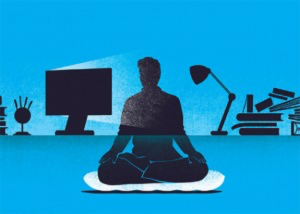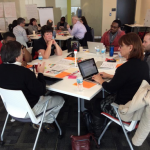Mindfulness: Cultivating Focus and Clarity

Today’s work environment is nonstop; there is no off the clock or 9-5. Employees are spending their days on autopilot. Checking off to-do boxes, attending meetings and answering calls. Employees are struggling to remain seated through a roller coaster of successes and failures. Where does all of this pressure lead? Exhaustion. People are losing focus, energy and productivity. Not to worry however, there is a solution. It is called mindfulness.
Mindfulness is the ability to intentionally pay attention to the present and to observe and participate in what every moment life has to offer. In the most basic terms, mindfulness is awareness. It allows us to recognize our feelings and emotions and keep them under control even when faced with highly stressful situations. The practice of mindfulness gives us the tools to manage our lives as we are living it; rather then being the passenger, we become the driver.
Mindful Management
To lead with excellence, we need mindful leaders. Leadership requires a person to juggle many responsibilities, which can create a distracted mind. A leader must be able to give their full attention to what they are doing and to do this, they must be present. To achieve this, a leader must practice focusing on what is truly important and block out the small distractions. When one can more fully focus, they can make more conscious decisions. The environment we work in today is constantly changing and evolving; making the need for awareness of the present a necessary skill.
Mindfulness does not only benefit the leader, but employees as well. In two studies published in the journal Mindfulness, researchers studied the effects of supervisors’ mindfulness on employees well being and overall performance. In addition to measuring the mindfulness in supervisors, the study also measured employees’ emotional exhaustion, work-life balance and overall job performance. Studies showed that the more mindful supervisors had employees with less emotional exhaustion, better work-life balance, and better overall job performance. The results of this study suggested that mindfulness improves social relationships, communication and empathic concern towards others.
How to Bring Mindfulness Into Your Daily Routine
Mindfulness may be something new to you. That’s ok, it is easy to get started. Here are a few tips on how to start implementing mindfulness into your daily routine to create a more present you:
- Make a commitment to practice. The first step is to become more aware of being aware.
- As you walk to your car on the way to work, check in with your body and notice any tension. Try to soften it.
- Drive to work slightly slower and allow red lights to be reminders to notice your breathing.
- Take a few breaths at your desk before checking any emails or updates.
- Practice really listening to others. Shift your energy to the other person and take the focus off you and your mental to-do list.
- Watch your language because the words you use cue your physiology. When you tell a colleague that you are “slammed” at work you are giving your brain signals that it is having an unpleasant experience.
- Take a few minutes to identify your desired outcome in certain interactions, such as an important call or meeting. Know your intention.
- Find time at the end of your day for self-reflection. Practice noticing without judging.




Leave a Reply
Want to join the discussion?Feel free to contribute!